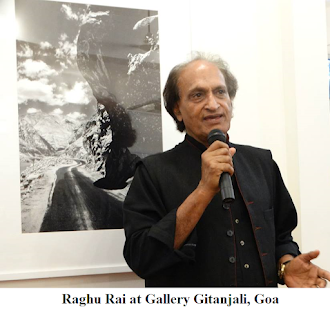The Matchless Raghu Rai
Himalayan Insights was India’s foremost photographer Raghu Rai’s contribution to Goa Photo 2015, an annual international photography festival. A collection of photographs selected from work done over the years; captured shots of the Dalai Lama and places such as Ladakh and Gangotri, made a startling impact on the viewer in their black and white avatar. Impressive in their depth, the photographs were lent an aura of poignancy by the lack of rainbow hues. ‘Images should have their own strength about them. They should be able to stand on their own. Some of them were in colour, but colour is pretty and predictable. Too many photographs appear as picture postcards with colour,’ says Mr Rai, explaining why the entire collection was in black and white.

Photo taken from Gallery Gitanjali Facebook page.
Rai’s exhibition at Gallery Delpire, Paris, in 1971, allowed him a nomination to the world’s premier photographic cooperative, Magnum Photos, after his work was duly noted by world famous photographer Henri Cartier Bresson. He is the only photographer to receive one of India’s highest civilian awards, the Padmashree, for his photographs covering the pitiful state of Bangladeshi refugees, the course of the Indo-Pakistan War of 1971 and Bangladesh’s subsequent independence from Pakistan.
His fascination with the country of his birth and determination to project her mysterious ability of holding in her embrace a multitude of cultures, religions and languages, is well brought out in numerous books such as Khajuraho (1991), Taj Mahal (1986/87) and The Sikhs (1984). His is a rare choice in a career in photography, of eschewing world travel to enhance his repertoire in favour of concentrating entirely on India.
Raghu Rai has been bestowed with high international acclaim being awarded the Photographer of the Year (1992) in the United States for the story "Human Management of Wildlife in India", which appeared in The National Geographic. The Officier des Arts et des Lettres was awarded to him by the French Government in 2009. His photo essays have appeared in the world’s most famous publications including Time and Life. Despite it all, Rai remains humble, a quality that perhaps contributes much to his ability to immerse himself in his subject completely, resulting in his brilliant photography. He responds to the epithet of India’s Greatest Photographer with a gentle laugh, ‘I’ve heard it so often that I’m used to it now.’
He maintains that while a photographer can be prepared to the hilt with the best of equipment, lighting and location, it is still possible to miss the mark. However, he touts creativity and expertise as better enablers in capturing the perfect shot. He says, ‘Sensitivity and feeling are very important. The photographer has to be receptive to his environment. Your own oneness with the situation matters. The ability to connect hundred per cent must be there.’
Raghu Rai has been part of the jury for the World Press Photo Contest and UNESCO’s International Photo Contest. More recently, he judged the finale of Nat Geo cover shot Season 3 on the National Geographic channel along with installation and visual artist Samar Singh Jodha and director of Delhi Belly, Abhinay Deo. His integrity with regard to adhering to his individual style is evident in his statement, ‘Trying to copy anybody else is the worst thing you can do. My advice to young photographers is to find their own style and do something unique.’
He refuses to be one of the herd and the students at the Raghu Rai Center for Photography are encouraged in the same strand of thought. They are not just taught the technical details of photography but stoked to discover their inner genius that will set them apart in a world where most photography, albeit pleasant to the eye, struggles to rise above the mundane.
Themes come to Rai as he involves himself with his surroundings. He says, ‘Take for example the Himalayas. The history and magic will take time to reveal itself. Just as the raag bhairavi provides the base and you have to go beyond it, you have the tools in photography, but you have to make something more of it. Don’t go into a situation with an idea in mind. Respond instinctively to nature and create something totally unique and different.’
An advocate of using new technology in photography, which he strongly believes gives him the freedom and control to achieve spectacular photographs, Raghu Rai has no favourites in his body of work. He says, ‘Every moment you capture matters. You keep adding to your system over the years. It’s just like every child is important. Favouritism to one damages the others.’
Under an assignment for Greenpeace International, Raghu Rai covered the 1984 Bhopal Gas Tragedy where over 500,000 people were exposed to methyl isocyanate gas and other chemicals, leading to the death of many. He remembers, ‘The place was full of sadness. There was death all around. I had to rise above the sad experiences to capture the tragedy… the extent of the tragedy.’
Mother Teresa has captured his imagination more than once as he photographed her with his camera. His admiration for the Saint of the Gutters becomes very clear as he says, ‘She was most dedicated to serving others. She didn’t care whether you were Muslim, Christian, Hindu or any other religion. She was someone very special. She went beyond Christianity to serve mankind.’
Raghu Rai’s photography travels beyond mere representation of substance. He brings to us every emotion hidden in a situation. A true master of his art, his endless passion and matchless experience do indeed make him India’s greatest photographer and one of the best in the world.
Photographs by Raghu Rai can be viewed on Instagram at @raghurai.official and raghuraifoundation.org
(Originally published in April 2015)



Comments
Post a Comment